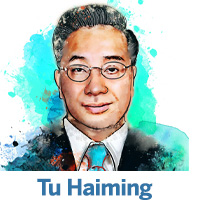Tu Haiming: Time is right for HK to launch low-altitude economic development ![]()
![]()
“Low-altitude economy” has become one of the buzz phrases in Hong Kong after Chief Executive John Lee Ka-chiu proposed its development in his 2024 Policy Address.

The Hong Kong Special Administrative Region government will set up a working group on developing a low-altitude economy, to be chaired by the deputy financial secretary, to strategize and promote low-altitude-economy development, which is expected to create a new growth area and thus has been well received by the Hong Kong community.
The low-altitude economy, with a broad scope covering extensive industry chains and new industrial models, holds enormous potential for development. Hong Kong must act boldly to ride on the wave of the low-altitude economy.
The low-altitude economy entails a comprehensive economic structure featuring low-altitude flight and operation of various unmanned and manned aircraft, associated services needed to facilitate airborne transportation, such as communication support, and ground services such as technical research and development and improvement of infrastructure.
The low-altitude economy has an extensive industry chain consisting of an upstream section, which mainly involves production of raw materials and components, including aviation components, aircraft engines and aircraft materials; a midstream section, including the assembly and installation of low-altitude aircraft, such as consumer drones, industrial drones, civil helicopters, electric vertical takeoff and landing aircraft and flying cars; and a downstream section, which covers a wide range of applications, including emergency rescue, firefighting, logistics and distribution, tourism, power inspection, meteorological observation, agriculture and planting, and security management.
The low-altitude economy takes on a new industry model characterized by its strong compatibility that can link a number of industries, such as aviation, the internet, big data, new energy, and new infrastructure. Apart from that, a low-altitude economy will facilitate a shift in the operation of many sectors. For instance, nowadays most of the couriers are “jockeys”; in the future they will mostly become drone operators.
On the Chinese mainland, the development of infrastructure for facilitating a low-altitude economy will be the next phase of its “infrastructure construction craze”.
As Premier Li Qiang noted in his Government Work Report delivered during the two sessions — China’s annual parliamentary meetings in March — the low-altitude economy is one of the focuses in developing the country’s new growth engines. Meanwhile, the resolution adopted by the third plenary session of the 20th Communist Party of China Central Committee in July also included the low-altitude economy as part of the broad effort in deepening reform comprehensively to advance Chinese modernization.
Currently, nearly 30 provinces and provincial-level areas in China have listed the low-altitude economy as a priority and introduced relevant policies in their respective government work reports. Understandably, 2024 is said to be the first year of the low-altitude-economy era.
According to the China Low-Altitude Economy Development Report released by market research firm CCID Consulting, the size of China’s low-altitude economy reached 505.95 billion yuan ($71.02 billion) in 2023 with a growth rate of 33.8 percent. The Civil Aviation Administration of China has estimated that the low-altitude economy will expand to 1.5 trillion yuan by 2025 and 3.5 trillion yuan by 2035.
As the mainland prioritizes the low-altitude economy’s development as a new economic growth point, it is also an opportune moment for Hong Kong to strategize and launch the development of this economic pattern.
Lee proposed in his latest Policy Address four focus points in developing the low-altitude economy: exploring low-altitude flying application scenarios, amending relevant regulations, promoting alignment with the mainland, and studying and planning for low-altitude infrastructure. They are, as I see it, very apt and to the point.
“Exploring low-altitude flying application scenarios” is the starting point of the low-altitude economy’s development. Although Hong Kong is small in geographical size, its dense population and economic vibrancy offer huge potential for low-altitude flight applications. The sort of applications that we already know include using drones for delivery, surveying, maintenance of buildings, aerial photography, the performing arts, and search-and-rescue operations. More and more applications are likely to be invented.
“Amending relevant regulations” focuses on achieving breakthroughs in easing restrictions. When technical conditions allow, restrictions on “beyond visual line of sight”, as well as on the weight and load of the drone, should be eased to expand the development potential of the low-altitude economy.
“Promoting alignment with the mainland” will create synergy by combining the resources of the two sides. The Policy Address proposed to “explore with the mainland authorities the joint establishment of low-altitude cross-boundary air routes, immigration and customs clearance arrangements and supporting infrastructure”, which will be instrumental to connecting the markets of both sides. In the future, the revenue of Hong Kong’s low-altitude economy will not only generate revenue locally, but also from the huge market on the mainland.
“Studying and planning for low-altitude infrastructure” aims to bolster the foundation underpinning the low-altitude economy. If every part of low-altitude flight activities, including landing sites, communication support, route design and safety management, is properly administered, the low-altitude economy will be firmly rooted.
By prioritizing the low-altitude economy as a key area of focus, the chief executive and the SAR government demonstrate their commitment to proactive governance to advancing the development of emerging industries.
The author is vice-chairman of the Committee on Liaison with Hong Kong, Macao, Taiwan and Overseas Chinese of the National Committee of the Chinese People’s Political Consultative Conference, and chairman of the Hong Kong New Era Development Thinktank.
Source from: China Daily.
https://res.youuu.com/zjres/2024/11/4/pFSG6RVlaNCPZpmUehdpo0VXJ3tZg5vO0PH.jpg











掃描二維碼分享到手機














